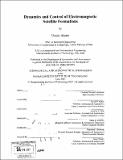| dc.contributor.advisor | David W. Miller. | en_US |
| dc.contributor.author | Ahsun, Umair, 1972- | en_US |
| dc.contributor.other | Massachusetts Institute of Technology. Dept. of Aeronautics and Astronautics. | en_US |
| dc.date.accessioned | 2008-11-10T19:56:33Z | |
| dc.date.available | 2008-11-10T19:56:33Z | |
| dc.date.copyright | 2007 | en_US |
| dc.date.issued | 2007 | en_US |
| dc.identifier.uri | http://dspace.mit.edu/handle/1721.1/40894 | en_US |
| dc.identifier.uri | http://hdl.handle.net/1721.1/40894 | |
| dc.description | Thesis (Ph. D.)--Massachusetts Institute of Technology, Dept. of Aeronautics and Astronautics, 2007. | en_US |
| dc.description | Includes bibliographical references (p. 197-203). | en_US |
| dc.description.abstract | Satellite formation flying is an enabling technology for many space missions, especially for space-based telescopes. Usually there is a tight formation-keeping requirement that may need constant expenditure of fuel or at least fuel is required for formation reconfiguration. Electromagnetic Formation Flying (EMFF) is a novel concept that uses superconducting electromagnetic coils to provide forces and torques between different satellites in a formation which enables the control of all the relative degrees of freedom. With EMFF, the life-span of the mission becomes independent of the fuel available on board. Also the contamination of optics or sensitive formation instruments, due to thruster plumes, is avoided. This comes at the cost of coupled and nonlinear dynamics of the formation and makes the control problem a challenging one. In this thesis, the dynamics for a general N-satellite electromagnetic formation will be derived for both deep space missions and Low Earth Orbit (LEO) formations. Nonlinear control laws using adaptive techniques will be derived for general formations in LEO. Angular momentum management in LEO is a problem for EMFF due to interaction of the magnetic dipoles with the Earth's magnetic field. A solution of this problem for general Electromagnetic (EM) formations will be presented in the form of a dipole polarity switching control law. For EMFF, the formation reconfiguration problem is a nonlinear and constrained optimal time control problem as fuel cost for EMFF is zero. Two different methods of trajectory generation, namely feedback motion planning using the Artificial Potential Function Method (APFM) and optimal trajectory generation using the Legendre Pseudospectral method, will be derived for general EM Formations. | en_US |
| dc.description.abstract | (cont.) The results of these methods are compared for random EM Formations. This comparison shows that the artificial potential function method is a promising technique for solving the real-time motion planning problem of nonlinear and constrained systems, such as EMFF, with low computational cost. Specifically it is the purpose of this thesis to show that a fully-actuated N-satellite EM formation can be stabilized and controlled under fairly general assumptions, therefore showing the viability of this novel approach for satellite formation flying from a dynamics and controls perspective. | en_US |
| dc.description.statementofresponsibility | by Umair Ahsun. | en_US |
| dc.format.extent | 203 p. | en_US |
| dc.language.iso | eng | en_US |
| dc.publisher | Massachusetts Institute of Technology | en_US |
| dc.rights | M.I.T. theses are protected by
copyright. They may be viewed from this source for any purpose, but
reproduction or distribution in any format is prohibited without written
permission. See provided URL for inquiries about permission. | en_US |
| dc.rights.uri | http://dspace.mit.edu/handle/1721.1/40894 | en_US |
| dc.rights.uri | http://dspace.mit.edu/handle/1721.1/7582 | en_US |
| dc.subject | Aeronautics and Astronautics. | en_US |
| dc.title | Dynamics and control of electromagnetic satellite formations | en_US |
| dc.type | Thesis | en_US |
| dc.description.degree | Ph.D. | en_US |
| dc.contributor.department | Massachusetts Institute of Technology. Department of Aeronautics and Astronautics | |
| dc.identifier.oclc | 196905565 | en_US |
